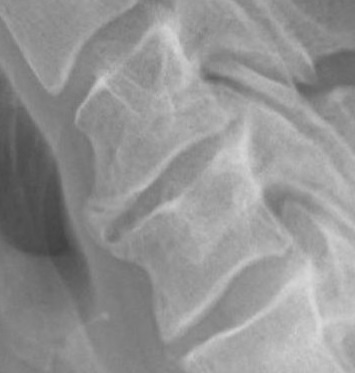The neck pain, like back pain in general, is a major public health problem. This is a frequent reason for consultation that can be attributed to multiple origins, including disc pinching C5-C6.
As its name suggests, it is a vertebral aging responsible for a collapse of the intervertebral disc separating the C5-C6 cervical vertebrae.
The following article is a detailed answer to questions concerning C5-C6 disc narrowing, its clinical forms, its etiologies as well as its various treatments.
Anatomical reminder of the cervical spine
La cervical spine is, in medical jargon, the name given to the bone structure that makes up the neck. It represents the first part of the spine and corresponds to the stack of seven cervical vertebrae separating the skull from the rib cage.
The first cervical vertebra is called theAtlas. Its anatomical design gives it the role of pivoting or bending the head back and forth.
The Atlas articulates with theAxis (2nd cervical vertebra) via articular facets and a bone structure called "Tooth" to allow lateral rotation movement, as if to say "no" with the head.
The rest of the vertebrae have a classic anatomical structure: body, intervertebral disc, arches and transverse spinous processes delimiting the vertebral foramen.
The intervertebral discs are located between each two vertebrae, and their tissue structure (ring of cartilage, gelatinous core) gives them a shock-absorbing role and allows great flexibility of the spine.
What is a C5-C6 disc narrowing?
Le disc pinching, also called disc compression is a condition that affects the intervertebral disc and is characterized by a decrease in its height. It is in fact one of the clinical forms of degenerative disc disease.
Disc narrowing c5-c6 corresponds to a decrease in the height of the intervertebral disc separating the two vertebrae c5 and c6 located at the base of the neck.
This pinching is linked to a Dehydration and disc wear which is generally the culmination of a process of vertebral aging accelerated by factors such as degenerative diseases,cervical spondylosis or lifestyle habits.
Pinching can occur at any level of the spine. However, it more frequently affects the cervical and lumbar vertebrae because of the importance of the impact of the stress suffered by these vertebrae.
The subjects affected by this pathology are often those who work in a seated position in front of a desk, but also certain employees such as truck drivers or jackhammer operators.
How is a C5-C6 disc narrowing manifested?
The most common symptom of C5-C6 disc narrowing is neck pain (cervical pain).
The pain is mechanical (related to the friction between the vertebrae) and is localized at the level of the intervertebral disc between C5 and C6.
The friction of two vertebrae can be manifested by a simple inflammation which is not necessarily painful, as it can induce, at an advanced stage of the disease, a rupture of the intervertebral disc with protrusion of its gelatinous substance describing what is called a herniated disc.
C5-C6 disc herniation affects the brachial plexus nerves that innervate the muscles of the upper limb (arms, forearms, shoulders and hands) as well as the head and neck. It is generally responsible for neurological symptoms such as bynumbness, tingling, feelings of burns, or even a muscular weakness.
In addition to the pain associated with the herniated disc, patients are often subject to degenerative disc disease. This occurs when the natural aging of the vertebrae is accelerated by the recurrence of poor neck posture and osteoarthritis.
Degenerative disc disease evolves spontaneously towards a spondylolisthesis which is however more frequent at the lumbar level.
The causes of a C5-C6 disc narrowing
Disc herniation C5-C6
This is a very common cause of C5-C6 disc narrowing. You have to think about it in the face of the symptoms described earlier in the article, but also in a patient who presents with weakness or even muscle atrophy of the upper limbs: mainly the muscles of the neck, shoulders and hands.
Traumatic cause
The pinching is in this case generated in a brutal way and the nature of the trauma can be related to a direct injury or an accident. It can be a work accident or an accident on the public highway, an injury linked to a violent sport (judo, boxing, etc.), or even the lifting of heavy loads.
The genetic factor
Genetics can play an important role in the genesis of a narrowed disc or any other back problem. Indeed, if you have a family history of disc narrowing, you could be genetically predisposed to the same problem.
In addition, certain risk factors are likely to trigger or worsen pinching. Among these factors:
- osteoarthritis
- Old age
- The dehydration
- Lifestyle habits (bad neck postures)
- Osteoporosis and taking corticosteroids
- Menopause
Diagnosis of C5-C6 pinching
Faced with symptoms suggestive of a C5-C6 disc narrowing, the doctor performs a complete physical examination with, in particular, a neurological examination focused on the entire upper limb.
Then, to support the diagnosis, he will give you the benefit of certain additional examinations based mainly on: a X-ray image stand of the cervical spine, a cervical MRI (medullary) and possibly a myelography.
Standard radiology can highlight the compression of C5 on C6 (or total flattening of the disc) as well as a reduction in the height of the cervical spine.
The spinal MRI will determine the degenerative state of the intervertebral discs and will detect the cause of a possible C5-C6 protrusion.
Treatment: what to do?
Like most back pain, the treatment of C5-C6 disc narrowing is initially based on prescription medication associated with physiotherapy or alternative therapies.
The medication
Usually, the doctor prescribes analgesics (paracetamol, aspirin) in tablets, non-steroidal anti-inflammatory drugs orally or topically.
Stronger painkillers such as opioids or corticosteroids may be prescribed to relieve moderate to severe pain.
Calcium and vitamin D supplementation may also be recommended, as a preventive measure or to reduce bone degeneration.
Alternative therapies
Several alternative therapies are adored by athletes for their effectiveness on low back pain, back pain, neck pain. Although not supported by solid scientific evidence, the following therapies are sometimes used:
- cupping
- acupuncture
- natural products
- grandma's remedies
- essential oils
- etc.
Physiotherapy or osteopathy
To correct the limitation of movement of the neck and improve its stability by relaxing the muscles.
Prescription of a neck brace
To immobilize and protect the neck following an acute trauma occurring at the level of C5-C6, or after surgery.
Acupressure therapy
The virtues of acupressure are drawn mainly from acupuncture. On the other hand, acupressure uses a acupressure mat which exerts pressure on the body using its pimples which will relax the muscles and stimulate the body's energy.
In the most advanced cases of the disease, such as the occurrence of a vertebral fracture, only orthopedic treatment (wearing a corset) or the use of surgery (cementoplasty, arthrodesis) can be considered.
For other strategies to relieve neck pain, see the following article.
My name is Anas Boukas and I am a physiotherapist. My mission ? Helping people who are suffering before their pain worsens and becomes chronic. I am also of the opinion that an educated patient greatly increases their chances of recovery. This is why I created Healthforall Group, a network of medical sites, in association with several health professionals.
My journey:
Bachelor's and Master's degrees at the University of Montreal , Physiotherapist for CBI Health,
Physiotherapist for The International Physiotherapy Center



